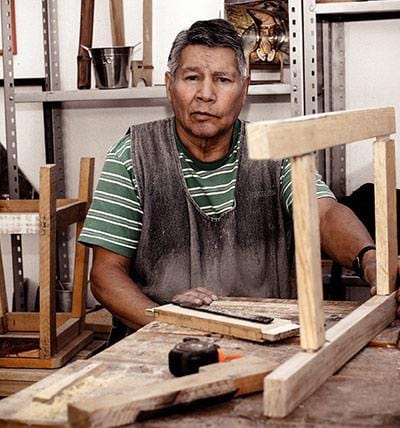Get ready to dive into the fascinating woodworking world and create your own homemade chess board! This step-by-step guide will walk you through the process, turning your plain pieces of maple and walnut into a stunning square of strategic brilliance. Grab your table saw; let's make some magic happen! We'll be working with wood glue, a trusty companion in the realm of woodworking. The secret lies in carefully arranging and gluing alternating strips of maple and walnut to form a mesmerizing pattern that'll make your opponents' jaws drop.
So, roll up those sleeves and get that miter saw ready. Oh, and don't forget your sander; it'll ensure those edges are as smooth as a baby's bottom. With every trim and thickness carefully measured, you'll soon be on your way to crafting a chessboard fit for a champion. Once the pieces are glued and clamped, it's time to step back, wipe the sweat off your brow, and let it dry.
Patience is key, my friend. Finally, please give it a protective finish coat, let it bask in the warm embrace of drying time, and voila!
Your homemade chess board will be ready to bring the battle of light and dark to life. So, grab your tools, fire up that browser for a few woodworking tips, and let your creativity take the edge off your dreams!
Step 1: Prepare the Materials and Tools for Your DIY Chess Board
It's like prepping for battle; you must have your arsenal ready. Gather that sturdy wood, like maple and walnut, to make a chess board that'll make folks go, "Wow!" Measure twice, cut once, they say, so make sure you've got the right width for those strips. And don't forget your trusty tools, mate! Dust off that saw, get that measuring tape ready, and let's not forget the wood glue—that secret sauce that'll hold it all together. Keep your outer zen intact by having a clean and spacious workspace. Lastly, my friend, once you've got everything in order, it's time to exercise some patience and let those materials dry, allowing them to come together and form the chessboard of your dreams. So, gear up, get those supplies in order, and dive into this chessboard-making adventure!

Step 2: Rip and Cut the Boards to Size
Here's what you have to do, my chessboard aficionado:
- First off, grab your trusty ruler, pencil, and nails. Measure twice, cut once, they say!
- Determine the size of your chessboard. It has to be just right to accommodate those fierce chess pieces.
- Take that wood board and lay it on a flat surface. We want everything nice and even, my friend.
- Now, use that saw of yours to rip the boards into strips. Remember, we aim for that classic checkerboard pattern, alternating light and dark. Talk about a visual feast for any chess player!
- Make sure those strips fit together snugly, my friend. No gaps allowed!
- Cut those strips with a crosscut to achieve the desired length. This is where precision comes into play.
- It's time to glue those strips together, creating the magnificent chessboard you've been dreaming of. Spread that wood glue around like a pro, ensuring every strip gets a good squeeze.
- Clamp those strips together and let the glue work its magic. We're talking steps 6, 7, and 8 of this chessboard-making dance.
- While the glue is drying, scrape off any excess that may have escaped the seams. We want a clean and polished look, my friend.
- Give that border around the chessboard a little love. Miter the edges for a touch of elegance and contrast.
- Once the strips and glue have dried completely, grab your 80-grit sandpaper and sand away any imperfections. We want that board to be smooth as silk!
- Apply a coat of polyurethane or your preferred wood finish to protect and enhance the beauty of your chessboard. Let that poly dry, my friend, and watch as your chessboard looks stunning.
And just like that, my chess enthusiast, you've ripped, cut, and glued your way to a masterpiece of a chessboard. Give yourself a pat on the back, and get ready to move on to the next step of this captivating chessboard creation.
Step 3: Sand the Boards for a Smooth Finish
Now we're getting closer to that polished perfection, my friend! Steps 7 and 8 are all about sanding those boards to achieve a smooth finish that'll make your chessboard shine like a star in a game of chess. Here's what you have to do:
- Grab your trusty 80-grit sandpaper and get ready to work on those boards.
- Start sanding away, making sure to cover every inch of the board. We want it to be as smooth as butter, my friend.
- Keep a keen eye on those edges. We want them flush and even, seamlessly transitioning from one strip to another.
- Don't forget to pay extra attention to the outer edge of the board. We want a clean border around the playing field.
- Keep sanding until your fingers can glide over the surface with no resistance. Smoothness is the name of the game here.
- Remember to brush off any sawdust that may have settled on the board. We don't want that to interfere with the final look.
- And just like that, your chessboard is one step closer to perfection. It's amazing how sanding can transform those raw plywood strips into works of art.
- Take a moment to admire your progress. Steps 7 and 8 have truly elevated how your chessboard looks. With those smooth and polished boards, you can move on to Step 9 and continue this chessboard-making adventure!
So grab your sandpaper, get in the zone, and bring out the true beauty of your chessboard, one stroke at a time. The result will be worth every grain of sand.
Step 4: Arrange and Glue the Strips to Create the Chessboard Pattern
All right, let's dive into it! So, here's the deal with arranging and gluing the strips to create the chessboard pattern. It's a crucial step, my friend, and it will give your chess board that eye-catching look. Now, please pay attention, because we'll break it down for you. In good ol' step 10, you must grab that dowel and split that panel right down the middle. Boom! Two pieces in your hands. Next, lay those strips on the table, side by side, and bring them together to form that fancy chessboard design. You want to ensure they fit nicely and snugly, so don't hold back on those clamps. And here comes the glue party!
Spread that gooey goodness evenly around the board, my friend. Don't be stingy now. Get it on every strip, spreading it around like a champ. Now, let's talk foam. Rip those boards into strips, and here's the trick: only glue them on every other strip. It's going to give your board that extra pizzazz. And hey, don't forget to sand it down with that 80 grit sandpaper. Smooth as a baby's bottom, baby!
Now, you must cut those boards at a mitered angle, adding flair to your creation.
And last but not least, give it a touch of mineral oil, my friend. Rub it in, and watch that chessboard shine like a star. And there you have it—a jaw-dropping chessboard ready to rule the game!
Step 5: Clamp the Boards and Let the Glue Dry
Alright, let's get down to business! Now it's time to clamp those boards and let that glue work its magic. So here's the deal, my friend. Remember step 11? Split that panel into two pieces; now you've got your playing field. Lay those strips out, align them like a pro, and combine them to form that stunning chessboard look.
Now, don't forget those ripped boards. You must place them on every other strip and clamp them down tight. We're talkin' a solid grip here. No wobbling around. Now, here comes the glue. Spread it on there like you mean it. Please don't hold back, my friend. Get it all over those strips, ensuring they're nice and covered. Oh, and remember that trusty cardboard underneath? It will catch any drips, so you don't make a mess. Alright, now it's time to let that glue dry. Patience is the name of the game, my friend. Walk away, let it do its thing, and come back later to see how that chessboard looks. Eight strips, cut boards, and a whole lot of clamping. You're on your way to chessboard greatness!
Summary
And there you have it, my friend! Making a homemade chess board isn't rocket science, but it sure brings out the craftsman in you. So, let's recap this little adventure, shall we? In step 11, you split that panel into two pieces like a boss, which became your game's foundation. Then you laid those strips side by side, aligning them with precision, and brought them together to form that classic chessboard pattern. Remember that glorious moment when you spread the glue all over those strips? It was like painting a masterpiece! And now it's time to step back and admire your handiwork. Take a good look, my friend, and see how that chessboard looks. Your hard work and dedication paid off. It's a thing of beauty! So gather your pieces, set them up, and let the game begin. Your homemade chessboard is ready to take on the world, one move at a time.

FAQs
How do I split the panel into two pieces?
No worries, my friend! Grab a trusty saw and cut that bad boy right down the middle to split that panel into two pieces. It's like a magic trick, turning one into two quickly. Voila! You've got the foundation for the chessboard right there.
How do I lay the strips together to form the chessboard pattern?
Ah, the chessboard pattern. It's a thing of beauty, my friend. Here's the scoop: lay those strips side by side, aligning them with utmost precision. It is like a puzzle, combining pieces to create that stunning pattern. Take your time, enjoy the process, and watch the chessboard come to life before your eyes.
How can I ensure my homemade chess board looks impressive?
Oh, we all want that wow factor, don't we? Well, my friend, it's all about the details. When laying those strips, make sure they're aligned perfectly. Take a step back, double-check, and make any adjustments needed. And don't forget the glue! Spread it evenly, like spreading love, ensuring every strip is coated. With attention to detail and a touch of craftsmanship, your homemade chess board will be the envy of all chess enthusiasts.
ABOUT THE AUTHOR
Fred Felton
Content Creator / Editor
Fred Felton is a copywriter, editor and social media specialist based in Durban, South Africa. He has over 20 years of experience in creating high end content. He has worked with some of the biggest brands in the world. Currently Fred specialises in the wooden arts and crafts space, focussing on innovative wooden product design. He is also a keynote speaker and has presented talks and workshops in South Africa.






